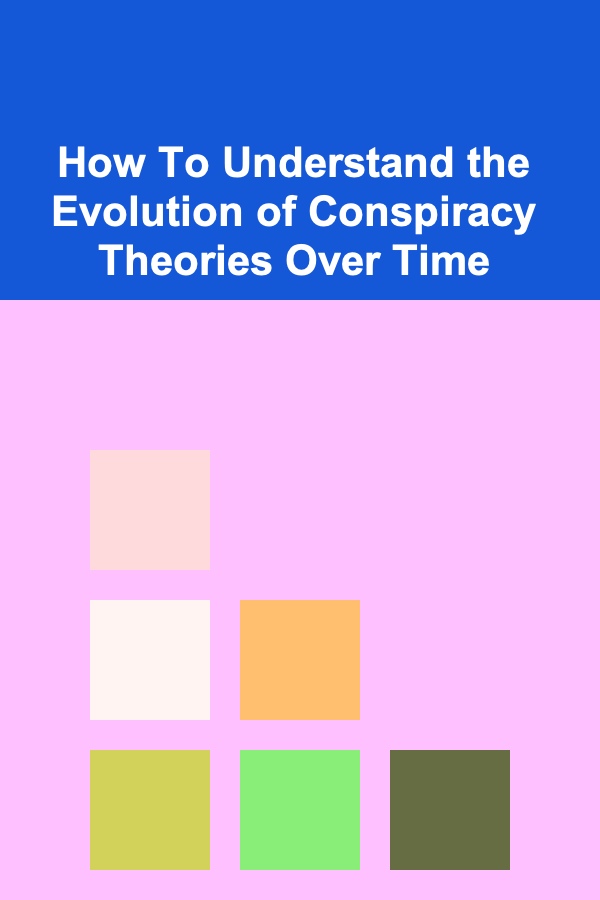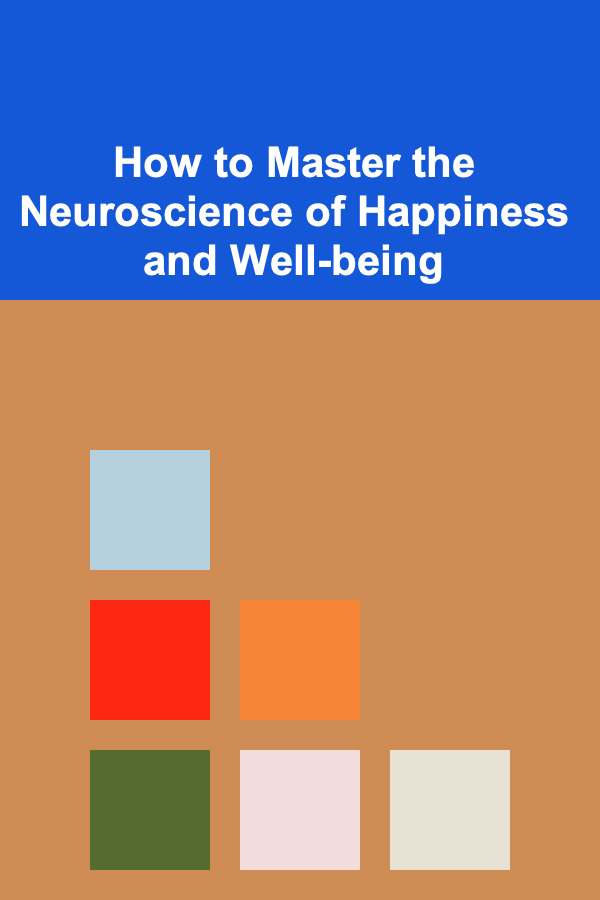
How To Understand the Evolution of Conspiracy Theories Over Time
ebook include PDF & Audio bundle (Micro Guide)
$12.99$7.99
Limited Time Offer! Order within the next:

Conspiracy theories have been a part of human society for centuries, but their prevalence, forms, and influence have evolved considerably over time. Theories that once emerged as responses to specific political events, societal anxieties, or scientific discoveries have transformed into powerful narratives that shape modern discourse. Understanding how conspiracy theories have evolved requires examining the psychological, social, and technological factors that drive them, and how they change in response to different eras.
This article will explore the evolution of conspiracy theories from their historical roots to their contemporary prominence, analyzing how they have adapted to shifting cultural, political, and technological landscapes. We will also look at the key factors that influence the spread of these theories and how they shape societal beliefs and behaviors.
The Birth of Conspiracy Theories: Early Foundations
Conspiracy theories are often thought to be a product of modern times, especially in the context of political upheaval, war, or global crises. However, the origins of conspiracy thinking can be traced back to the ancient world. Ancient civilizations, including the Egyptians and the Greeks, had myths and beliefs about secretive plots and hidden forces that shaped their societies. These early conspiracy theories were often related to divine intervention or manipulation by unseen forces, reflecting a desire to understand the complex and sometimes chaotic world around them.
One of the earliest known conspiracy theories can be traced to the time of the Roman Empire, when political intrigues and secret alliances often fueled distrust among the populace. Roman historians, such as Tacitus and Suetonius, wrote extensively about the plots and conspiracies that plagued the empire, often attributing political outcomes to hidden machinations. These early conspiracy theories were typically tied to the ruling elite, who were seen as using covert methods to maintain power.
In the medieval period, conspiracy theories took on a religious tone. The rise of Christianity and Islam led to fears of hidden forces working against the faith, whether in the form of heretics, infidels, or rival religious sects. The Crusades, for instance, were partly fueled by conspiracy thinking about the intentions of rival powers, and the Catholic Church often accused others of secret, nefarious plots. These religious conspiracies were deeply intertwined with the political and social order, highlighting how conspiratorial thinking was used to justify power structures and frame conflicts as a battle between good and evil.
The Renaissance and Early Modern Period
The Renaissance and early modern period saw the rise of more sophisticated conspiracy theories, especially in Europe. During this time, new ideas about politics, religion, and science began to challenge the established order. The Protestant Reformation, for example, gave rise to a slew of conspiracy theories about the Catholic Church, accusing it of corruption, manipulation, and secrecy. These theories were often framed within a narrative of religious reform and resistance to institutional power.
In the 17th and 18th centuries, the Enlightenment brought about a shift in the way people thought about knowledge and authority. However, this intellectual movement did not eliminate conspiracy thinking. Instead, it transformed it. The Enlightenment encouraged skepticism about absolute authority and revealed the extent to which powerful elites could manipulate society. Conspiracy theories about government, monarchies, and secret societies began to flourish during this period. The Freemasons, for example, became a popular target for conspiracy theorists who believed that the secretive organization was involved in a global plot to control politics, economy, and religion.
These early modern conspiracy theories were closely tied to social movements and were often a response to rapid political changes, such as the rise of democracy, the French Revolution, and the American Revolution. As new forms of government emerged, conspiracy theories about elite control and hidden agendas began to circulate more widely.
The 19th Century: Conspiracy Theories and Political Upheaval
The 19th century witnessed significant political and social upheaval, which fueled the rise of more complex and widespread conspiracy theories. The Industrial Revolution, the spread of colonialism, the rise of nationalism, and the challenges posed by modernity created an environment ripe for the development of conspiracy theories.
One of the most notable conspiracy theories of this time was the rise of anti-Semitic conspiracies. The infamous text "The Protocols of the Elders of Zion," which emerged in the early 20th century, falsely claimed to document a Jewish plot to dominate the world. This conspiracy theory would go on to influence much of the 20th century's anti-Semitic rhetoric and political movements, including Nazi ideology.
During the 19th century, conspiratorial thinking also became more intertwined with the rise of secret societies, particularly those associated with Freemasonry and Illuminati. As the world became more interconnected through communication and transportation, these secret societies were imagined to have global reach and influence, controlling everything from politics to finance. This reflected a growing distrust of powerful elites and the idea that unseen hands were manipulating events on a grand scale.
Additionally, the 19th century saw the emergence of conspiracy theories related to scientific advancements. For example, the theory of evolution, proposed by Charles Darwin, was met with fierce resistance from religious groups, who saw it as a challenge to their belief systems. This resistance often took the form of conspiracy theories that accused scientists of hiding the "truth" about human origins or manipulating evidence to promote a godless worldview.
The 20th Century: The Explosion of Mass Media and the Rise of Global Conspiracies
The 20th century marked a dramatic shift in the scope and influence of conspiracy theories. The advent of mass media---radio, television, and, later, the internet---allowed conspiracy theories to spread rapidly and reach a global audience. During the early part of the century, political events such as World War I and World War II created fertile ground for conspiracy thinking, as governments engaged in covert operations, espionage, and misinformation campaigns.
World War I and II
The two World Wars, in particular, had a significant impact on the development of modern conspiracy theories. The vast scale of these conflicts, coupled with secretive operations such as espionage, black ops, and disinformation campaigns, led many people to believe in the existence of large-scale, secret plots orchestrated by powerful elites. The idea that global conflicts were controlled by shadowy forces began to gain traction, with theories suggesting that wars were manufactured by bankers, industrialists, or secret societies to further their own interests.
After World War II, the Cold War intensified the climate of suspicion, with both the United States and the Soviet Union accusing each other of engaging in covert operations and conspiracies. The development of nuclear weapons and the constant fear of espionage led to widespread paranoia and the belief that world events were being manipulated by unseen forces.
The Rise of the "Conspiracy Industry"
As the 20th century progressed, the increasing availability of media channels, such as television, newspapers, and later the internet, made it easier for conspiracy theories to reach a wider audience. In particular, the 1960s and 1970s saw a boom in conspiracy theories, fueled by political scandals such as Watergate, the assassination of President John F. Kennedy, and the Vietnam War. These events, coupled with growing distrust of the government, led to an explosion of conspiracy theories, many of which were centered around the idea that powerful elites were manipulating events for their own gain.
This period also saw the rise of a "conspiracy industry," with books, documentaries, and alternative news outlets dedicated to exploring and promoting conspiracy theories. This media landscape contributed to the normalization of conspiracy thinking, making it easier for people to find like-minded individuals who shared their beliefs.
The Digital Age: The Rise of Social Media and the Fragmentation of Truth
In the 21st century, the internet has become a key driver of conspiracy theory proliferation. Social media platforms, websites, and online forums have allowed conspiracy theories to spread more quickly and widely than ever before. This digital age has introduced a new era of disinformation, where false narratives can be spread instantly across the globe. The proliferation of social media platforms such as Facebook, Twitter, and YouTube has created an ecosystem in which conspiracy theorists can find and connect with others who share their beliefs, creating echo chambers where misinformation is amplified.
The rise of "alternative media" sources, often fueled by social media influencers, has contributed to the growing distrust of traditional sources of information, such as mainstream news outlets. In this environment, conspiracy theories often present themselves as the "truth" that the mainstream media is allegedly hiding, making it difficult for individuals to distinguish between fact and fiction.
The Role of Algorithms
The role of algorithms in the spread of conspiracy theories is another key factor in understanding the evolution of these beliefs in the digital age. Social media algorithms are designed to prioritize content that engages users, and conspiracy-related content often performs well in this regard. As a result, people are more likely to encounter and engage with conspiracy theories, creating a feedback loop that reinforces their beliefs.
Moreover, the anonymity provided by the internet has allowed individuals to spread conspiracy theories without facing the same social or professional consequences that they might have encountered in the past. This has led to the rapid expansion of conspiracy networks, which are often organized around particular beliefs or grievances, such as anti-government sentiments, anti-science rhetoric, or extremist ideologies.
The COVID-19 Pandemic and the Amplification of Conspiracy Theories
The COVID-19 pandemic is a recent example of how global events can fuel the spread of conspiracy theories. Throughout the pandemic, conspiracy theories about the origins of the virus, the effectiveness of vaccines, and government responses to the crisis have flourished. The combination of widespread fear, uncertainty, and misinformation has created a perfect storm for the growth of conspiracy thinking, which continues to have a profound impact on public health and social cohesion.
Conclusion: The Future of Conspiracy Theories
The evolution of conspiracy theories reflects broader social, cultural, and technological changes throughout history. From ancient myths to modern disinformation campaigns, conspiracy theories have adapted to the unique challenges and anxieties of each era. As we move further into the digital age, the proliferation of conspiracy theories shows no signs of slowing down. Understanding the historical roots and contemporary factors driving conspiracy thinking is essential for combating its influence and ensuring that society remains grounded in evidence-based reasoning and critical thinking.
In the future, the challenge will be to develop strategies to combat the spread of misinformation, whether through improved media literacy, regulation of social media platforms, or promoting critical thinking. Only by understanding the evolution of conspiracy theories can we hope to address the underlying causes and reduce their harmful effects on society.
Reading More From Our Other Websites
- [Home Lighting 101] How to Brighten a Small Space with Strategic Lighting
- [Metal Stamping Tip 101] How to Achieve Consistent Tolerances in Thin‑Gauge Aluminum Stamping
- [Organization Tip 101] Why Establishing a Designated Mail Area is Important
- [Home Party Planning 101] How to Prepare for Dietary Restrictions in Your Menu
- [Gardening 101] From Seedlings to Harvest: How a Greenhouse Kit Can Transform Your Gardening Game
- [Home Cleaning 101] How to Clean a Dishwasher Filter After Every Use: A Quick Maintenance Routine
- [Personal Care Tips 101] How to Use Acne Treatment Cream to Reduce Inflammation and Redness
- [Home Pet Care 101] How to Keep Pets Safe During Travel: Tips for a Stress‑Free Journey
- [Trail Running Tip 101] Mastering the Terrain: Progressive Training Plans for Aspiring Trail Runners
- [Organization Tip 101] How to Organize Pet-Related Documents and Records

How to Optimize Your Spending for Maximum Savings
Read More
How to Use Recycled Materials for Eco-Friendly Holiday Decor
Read More
How to Use Upwork to Make Money
Read More
How to Master the Neuroscience of Happiness and Well-being
Read More
How To Leverage the Power of Peak Performance States
Read More
How To Discover Novels That Are Perfect for Learning
Read MoreOther Products

How to Optimize Your Spending for Maximum Savings
Read More
How to Use Recycled Materials for Eco-Friendly Holiday Decor
Read More
How to Use Upwork to Make Money
Read More
How to Master the Neuroscience of Happiness and Well-being
Read More
How To Leverage the Power of Peak Performance States
Read More